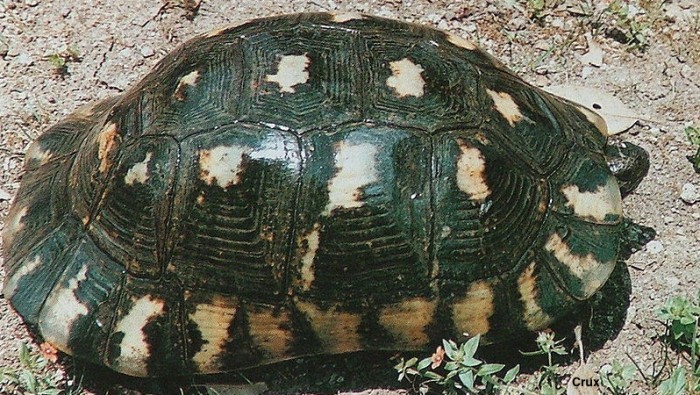Marginated Tortoise (Testudo marginata)
Natural history
The marginated tortoise is found in Greece and Sardinia, as well as Italy, southern Albania, and the Balkan Islands. This species was also introduced into Turkey. Its natural habitat consists of dry scrub, woodland, and hillsides.
Conservation status
The marginated tortoise is listed on CITES Appendix 2 and its conservation status is listed as “least concern” by the International Union on Conservation of Nature (IUCN). Most animals in the pet trade come from captive breeding.
Taxonomy
Class: Reptilia
Order: Chelonia/Testudines
Family: Testudinidae
Genus: Testudo
Testudo marginata
Testudo marginata marginata
Testudo marginata sarda
Depending on the source, Testudo weissingeri is classified as either a separate species of genus Testudo or a subspecies of the marginated tortoise.
Physical description
Testudo marginata is the largest species in the Testudo genus. Adults range from 25-40 cm (10-15.7 in) in length and weigh up to 5 kg.
Testudo marginata and Testudo weissingeri have similar identifying features, and T. weissingeri was originally considered a dwarf population of Testudo marginata. The shell length of T. weissingeri is normally less than 21.5 cm (8.5 in). Testudo weissingeri can also be visually distinguished from Testudo marginata by carapace coloration.
- Carapace coloration in T. weissingeri is dull brown or blackish, with greyish-yellow or horn-collared patches flecked with grey.
- Testudo marginata possess a more contrasting pattern of pale yellow on black.
Marginated tortoises possess an oblong, domed shell. The supracaudal and posterior marginal scutes are prominently flared and “saw-like”. There are also four or five longitudinal rows of enlarged scales on the anterior surface of the foreleg. Usually there are no spurs on the tail or thighs.
Diet
The free-ranging marginated tortoise is herbivorous, consuming primarily grasses, flowers, and some fruits. The majority of the captive diet should consist of greens, grasses, and flowers, some vegetables and small amounts of fruit. A shallow bowl or plant saucer should be provided for access to water for soaking and drinking. See the Mediterranean Tortoise Basic Information Sheet for additional information.
Housing
| Temperature | The daytime temperature gradient should range from 26°C-30°C (78.8-86°F) with a basking spot that reaches 30°C-33°C (85°F-90°F). The nighttime temperature should fall no lower than 18°C (64.4°F). |
| Lighting | Artificial UVB lighting is recommended for captive specimens. Visit the Mediterranean Tortoise Basic Information Sheet for additional information. |
| Cage size and design | If possible, outdoor housing is preferred during warm weather months. Most Testudo marginata are quite hardy and will cope outdoors in well-drained herbaceous areas that are protected and enclosed. Indoor housing must be large enough to allow roaming. |
Visit the Mediterranean Tortoise Basic Information Sheet for additional recommendations including information on brumation.
Physiologic values
| Reproductive season | April to June, eggs laid June, July |
| Eggs per clutch | 3-11 |
| Laying site | 10 cm (4 in) deep excavations |
| Incubation | 2-4 months, depending on soil temperature |
Venipuncture
The brachial/ulnar venous plexus can produce less hemodilution than the dorsal coccygeal vein in T. marginata. See the Mediterranean Tortoise Basic Information Sheet for additional information.
Preventive medicine
Important medical conditions
Tortoise herpesvirus 3 (TeHV3) infection can cause severe disease and high morbidity and mortality in Testudo marginata. See the Mediterranean Tortoise Basic Information Sheet for additional information.
Quiz
Click here to access LafeberVet’s Testudo Tortoise Fast 5 Quiz.
**Login to view references**
References and further reading
References
Chitty J, Raftery A. Essentials of Tortoise Medicine and Surgery. Wiley-Blackwell. 2013.
de Vosjoli P. Tortoise husbandry 101. Exotic DVM 2003;4.6:27-30.
Eatwell K. Captive care of Mediterranean tortoises (Testudo sp). Irish Vet J 2009;62(2):125-129.
Highfield AC. Basic care of Mediterranean tortoises. The Tortoise Trust. Available at http://www.tortoisetrust.org/articles/Basicmedcare.htm. Accessed June 8, 2014.
Hunt CJG. Herpesvirus outbreak in a group of Mediterranean tortoises (Testudo spp). Vet Clin North Am Exot Anim Pract 2006;9:569-574.
Mader DR. Reptile Medicine and Surgery, 2nd ed. Saunders. 2005.
Mader DR, Divers SJ. Current Therapy in Reptile Medicine and Surgery. Saunders. 2013.
Mayer J, Donnelly TM. Clinical Veterinary Advisor: Birds and Exotic Pets. Saunders. 2012.
McArthur S, Wilkinson R, Meyer J. Medicine and Surgery of Tortoises and Turtles. Blackwell Publishing. 2004.
Oruçi S. Data on geographical distribution and habitats of the marginated tortoise (Testudo marginata Schoepff, 1792) in Albania. Natura Montenegrina, Podgorica 2010;9(3):495-498.
van Dijk PP, Lymberakis P, Böhme W. 2004. Testudo marginata. The IUCN Red List of Threatened Species. Version 2014.3. Available at www.iucnredlist.org. Accessed on January 7, 2015
Pollock C, Kanis C. Basic information sheet: Marginated tortoise. March 18, 2015. LafeberVet Web site. Available at https://lafeber.com/vet/basic-information-sheet-marginated-tortoise/
